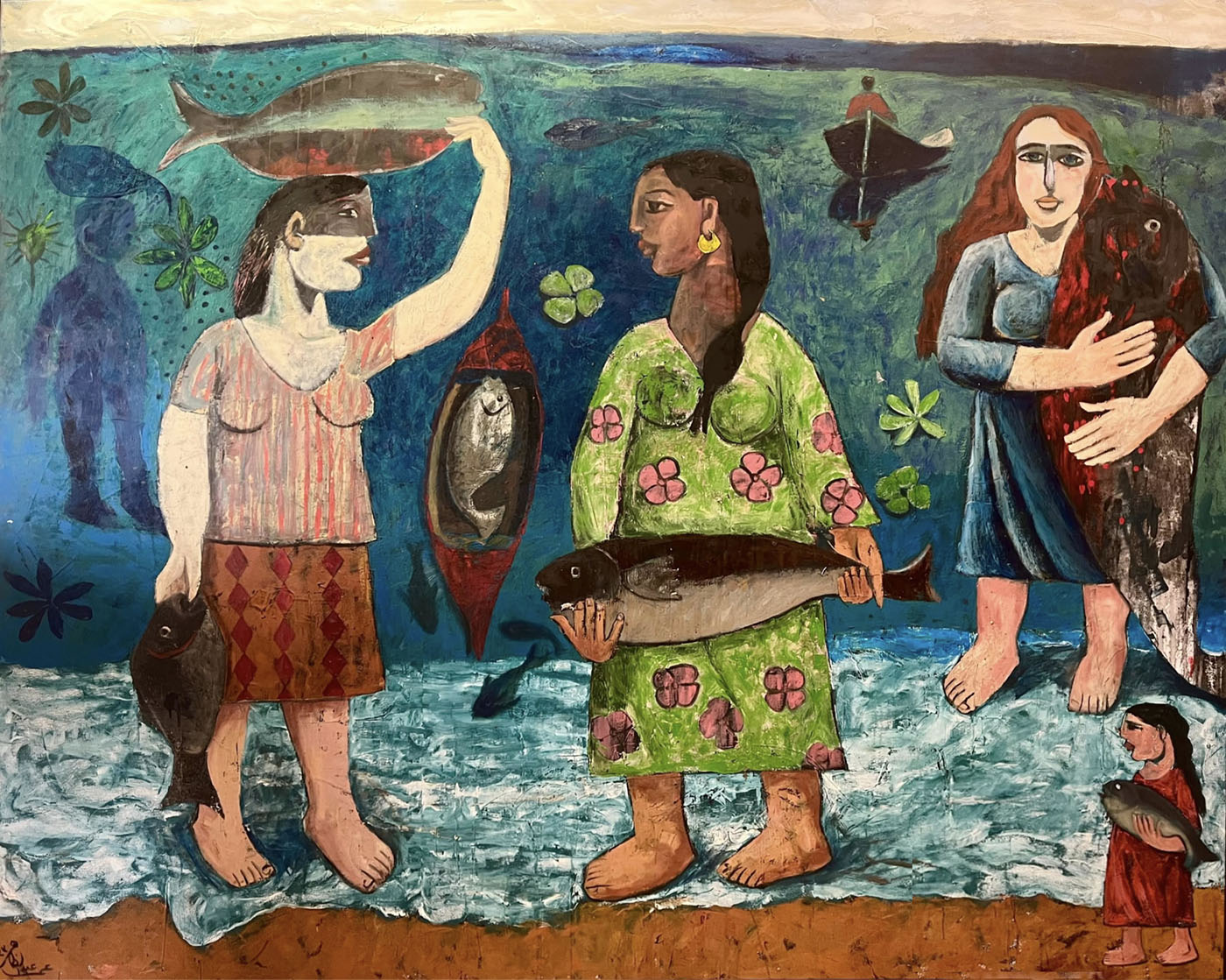Observation makes you a doctor, but being attentive to what lies at the margins of medicine is what makes you a good doctor.
Sarah Shaheen
Translated from the Arabic* by Lina Mounzer
Ever since my undergrad years, I’ve been fascinated by this term they use in obstetrics. The grand multipara, i.e., “the great giver of multiple births,” i.e., a woman who’s given birth five or more times. The term is clinically intended, its grandeur not meant as a form of exaggerated reverence as in, say “Great Britain” or the “Great Socialist People’s Libyan Arab Jamahiriya,” but rather as a warning of the long list of complications the woman and her fetus might face. Yet I still regard the bearer of this title as though she were indeed great. In my mind’s eye, I see her surrounded by a halo, like a rock star in the world of obstetrics.
Yesterday, I delivered a baby from one of those stars, a true grand multipara of natural childbirth. Such women are usually champions of natural childbirth, formidable women from Al-Saeed in Upper Egypt, who seem unfazed by labor or the number of miscarriages they’ve endured. Or so it seems. This woman entered the labor triage room with a preternatural calm, showing no signs of pain, but announcing she was in labor. That terrified me, because grand multiparas have uteri so well-versed in fetal ejection they sometimes give birth with such force that the baby launches like a rocket to the ground, or into the doctor’s face, or in any unpredictable vertical or horizontal direction. And so, despite her unnatural composure, I believed her immediately. I would never dare dispute a grand multipara on matters of labor, no matter how well-armed I am with the highest degrees in obstetrics. Indeed, the woman was in labor.
There are so many things about these women that arouse my curiosity. I love their oral tradition, all those ritual stories with which they describe giving birth. This particular woman had brought along her sister-in-law, also a grand multipara. The sister-in-law asked her calmly whether she’d experienced any “la‘s” yet. The patient replied that she hadn’t reached that stage, but there’d been “salabeel.” I was consumed by curiosity. I wanted to decode these terms, to be able to translate them into the Latin medical terminology I know. They hinted at a deep and impenetrable cultural wellspring — an enclosed, tight-knit world of women who may not have had any formal education, but who’d taught themselves more than enough to know how to keep human life alive and ongoing, and, as much as possible, to keep themselves safe, over the years.
I later learned that la‘s refers to lower abdominal pain — consistent with labor contractions — while salabeel is the blood-tinged mucosal discharge that precedes birth and indicates the start of cervical dilation.
I also love their inexplicable observations, the kind I can’t link to any respectable empirical science. For example: they believe indisputably that girls are born after strong, fast contractions and are easy to deliver, while boys cause “cold” contractions and difficult labor. How many women told me this same thing? If I had the chance, I’d search for a scientific explanation, because they trust what they say about their bodies. And while their traditions undoubtedly contain erroneous practices and some pretty outlandish beliefs, to reject them all outright is, in my view, arrogant intellectual snobbery and foolish besides. I love empirical science and reject superstition — but who said all their knowledge is superstition? Who said there isn’t empirical insight embedded in what they know? How could there not be, when they’ve undergone hundreds of births over the years, their bodies serving as the test sites?
Yesterday, my multipara patient closed her eyes and told me, in the tone of a Sufi sage from a Naguib Mahfouz novel: “Sit by me, and when the time comes, I’ll tell ya.” A diva, daughter of a diva.
But what intrigues me most about these women is what goes on inside their minds. Since my teenage years — since reading The Bell Jar and Sylvia Plath’s description of childbirth as a “black tunnel of agony that leads to the soul,” and reading the memoir of legendary dancer Isadora Duncan, where she recalls the birth of her eldest daughter Deirdre as a “massacre of [her] living body”— I’ve been haunted by the psychological toll of childbirth on women. Because I’ve seen those dark tunnels in the souls of educated, urban patients who’ve given birth once or twice, and I know those tunnels are real. Which is why I’m astounded by the composure with which these rural women treat birth, as if it were part of some daily routine like going to work, or was an unconscious biological function, like breathing. They give birth and go back to their lives immediately. Labor doesn’t terrify them; miscarriage doesn’t shake them. So: where do their dark tunnels lead?
Do they get used to it? Can one ever really get used to something that brutal? Are these women exceptionally strong? Or are they simply resigned to their biological and social fates because they don’t know, or can’t imagine, any other possibility? Could my patient have had a different life, one where she didn’t give birth eight times before the age of thirty-five? Does knowledge sharpen pain? Does awareness — of the world, of one’s misery, of bad luck — intensify suffering? Or is it a cultural thing, as those who give birth multiple times usually come from traditions that acculturate their members to fortitude and endurance? Maybe it’s a class thing, since the woman who births many children to help her carry all the hardships of life doesn’t — in most cases — have the luxury to dwell on her physical or emotional pain. And so she accepts everything; speaks to you of the worst tragedies with disarming gentleness, recalls the most agonizing experiences with a half-smile. And, in the very moment of active labor, when a human the size of a mule is pushing out of her delicate but strong body, she’s reminding her husband about turning off the gas, packing the baby’s clothes, and paying the kids’ school fees. Miraculous beings, these women. I swear they dazzle me. And when they tell me that a woman in labor is holding God’s hand and standing directly in His shadow, I believe them, no questions asked. Because that level of strength, that calm, surely must be God’s shadow itself.
Medicine, like any constant and demanding practice, is what philosopher L.A. Paul calls a transformative experience, meaning an experience you can’t predict or imagine in advance, because it changes you completely. Like motherhood, or a lifetime’s career, or marriage. Non-transformative experiences like eating and drinking have predictable outcomes: if I eat I’ll get full, or I might get a stomachache. Generally though, you remain the same as before. But medicine is a transformative experience, it remakes a person into someone else. It reshapes your understanding, your level of endurance, the kinds of things you can endure, and most importantly, changes the way you see everything.
I’ve been obsessed with that phrase ever since I came across it in W.G. Sebald’s The Rings of Saturn — so much so that I decided to write an entire book just to have that as its title. In The Rings of Saturn, Sebald describes the 18th-century physician Sir Thomas Browne and his obsession with death, decay, and decomposition, even though he was, paradoxically, a healer of the living. Of Browne, Sebald writes: “The doctor, who perceives the growth and spread of disease within his own body as clearly as in those he tends, understands the nature of decay better than the nature of life, and the miracle to him is that we should last even a single day.” As Browne himself wrote: “And indeed, no antidote has ever been found to the opium of time.” According to Browne, the physician — through the practice of medicine, through his knowledge of pathology and disease, through remaining attuned to how bodies stay alive despite everything lying in wait to destroy them — sees “the ruin latent in everything.”
This, to me, is the essence of the medical gaze, and the heart of its transformative effect on the physician. The medical gaze is hyper-observant. So obsessively observant it turns the living human body into a mental anatomical model. I speak to a patient while attuned to her posture, gait, any evidence of pain on her face, her skin tone and the level of swelling in her feet. The medical gaze is captivated by the possibility of decay. It sees potential illness in every healthy body, disaster in every labor that seems to be going fine, the possible crash and failure of each body “holding together” on the operating table.
The medical gaze detaches the physician from their human self, it forces a suspension of empathy, of seeing the patient’s humanity, abstracting them into a mere site of illness. It’s like a riptide: the more you try to pull yourself out, the harder it pulls you under. But it’s necessary. Without the distance of that gaze, you’d be unable to practice medicine with the precision and effectiveness required.
To best serve the patient, you must surrender to this gaze, and then be able to pull yourself out at the right moment to re-engage and empathize with her humanity, to acknowledge the context within which she exists, and the power it holds over her fragile body. You must be able to alternate between both states, stepping in and out at the right time. It’s exhausting. It might even drive you mad. But it’s essential.
When I’m at the lithotomy chair, guiding a patient through vaginal delivery, my mind is entirely focused on the birth canal and its surroundings, on the entry and exit points of the sutures, on proper tissue alignment, on the possibility of internal tears or injury. In that moment, my entire being is engaged in the anatomy, its magnificence, in my care for it. Then I finish, remove my Macintosh, that is, my plastic obstetrics apron, and see my patient’s face: grateful, tired, gentle. And every time — every single time — I’m astonished by that moment, which always feels new, when the abstract body by which I’ve been absorbed merges once again with its expressive human face. The medical riptide draws me out, but the tide of human connection pulls me back into the embrace of the patient’s full humanity.
The medical gaze transforms you into a noticer, a describer, an analyst. That’s an acceptable state of being, acceptable when applied to animals, geography and nature. But the moment that gaze is turned onto human life, a thousand delicate questions arise. I understand this fully. It is, after all, a rude, unfeeling gaze. But I can’t help being beholden to it.
I remember the first time I saw a bilateral frontal lobe infarction, a stroke that affects the brain’s centers of personality, behavior, and higher function. It had turned the patient back into a child, to the point of displaying those primitive reflexes seen only in infants. I placed my finger in his hand, and he gripped it instinctively like a newborn. My breath quickened in excitement as I read the scan and translated it onto his body, seeing signs in his movements that matched the lesion in his brain. I relayed his case summary eagerly, even lightly, to friends. But then his daughter came up to ask about his condition, and my heart sank. That was the moment I learned to discipline the student in me. I was deeply ashamed. The instance of my clinical joy was also that of a family’s collapse.
But I also learned that this gaze — excessively curious, pathological, attentive, analytical and always documenting — is what makes you a physician, a doctor. In How Doctors Think: Clinical Judgment and the Practice of Medicine, philosopher Kathryn Montgomery describes the doctor’s mind, how it is guided by medical texts and previous instructions, but maintains that the essence of being a doctor lies in an intuition developed by practice and experience, shaped out of observing things that can only be perceived by that medical gaze. So much so that a single glance at a patient might yield insights more precise than what any finely-calibrated test could ever reveal.
And so that’s what I do: I observe and observe. But this never distracts me from surrendering to the precision of medical practice. Observation takes shape through repetition; it demands unwavering and consistent attention. Just as you learn to balance the dueling tides of the clinical gaze and human compassion, you also learn to examine a patient as an entire being, contextualized within their social, gender and economic classes — all while treating them with professional rigor and mercy. All in the hopes that these peripheral insights will ultimately refine your practice of medicine.
Observation makes you a doctor, but being attentive to what lies at the margins of medicine is what makes you a good doctor. In theory, in textbooks, I learned that the first thing you must tell a mother who loses her pregnancy is, “It’s not your fault.” Yet in practice, I’ve met women who needed to hear exactly those words — and others who never even considered blaming themselves, who saw miscarriage like an entirely natural occurrence. Had I approached the latter like the former, I’d have seemed a presumptuous fool. And if I’d failed to notice that the first group were often urban and educated, and the second frequently rural and not much schooled, I’d have been blind.
And so: I observe, I record, I reflect, and I try to understand why. This pursuit is separate from the minutiae of medical practice — from delivery techniques, the diagnosis of illnesses or drawing samples for labs. It’s a third eye that never stops seeing, never stops marveling. It ascribes no aesthetic quality to that at which it marvels; it perceives neither the beautiful nor the sublime. It is fascinated rather by disease and its manifestations, no matter how destructive. It’s captivated by rare and complex cases. It thrills at them, documenting suffering with clinical detachment and raw honesty. It eschews empathy, tears and sentiment, preoccupied only with recording each case with the accuracy it deserves.
The more you observe, the more you learn, and the more complex grows your web of knowledge. I came to medicine having read dense philosophical texts that denounced obstetricians as criminals for ushering human souls into a hideous world. I devoured books that deconstructed the sanctity of motherhood and analyzed the burden of the female body. I came to medicine with a head laden with theory, but devoid of the messy wisdom of hands-on experience. Then: I encounter a woman in labor praying for death, clawing painfully hard at my scrubs. No child is worth this, I think. And yet she desperately wants this child! So: I revise my tidy philosophies. I humble myself before the truth and before the world. I ask myself what role I might play to make her life better. I try to ease the pain of her labor, I tell her how strong she is, how amazing. I try to heal the ravages that birth has wrought on her body. I learn. I improve.
Even the grand multiparas make me angry — all while dazzling the doctor in me. I get anxious, remembering what Martha Nussbaum wrote about epistemic injustice, which is when a person doesn’t know they’re being oppressed, and hermeneutical injustice, which is when they know but lack the language to explain it. And I think: surely, she falls under one of those categories. So I oscillate between the gaze of a clinician, the wisdom of a reformer and the rage of a social justice warrior.
Yet when I speak to her, I go to her; I don’t force her to come to me. Were I to throw the entire truth of her reality at her all at once, while she’s still in the vulnerability of her illness, she’d reject every word of it. Before anything else, she is my patient. We need to take care of all that first, and then we can talk. In her language, according to her values. But I’ll be pulling her gently, incrementally, toward me the whole time. Because the goal isn’t to win an argument, or to impose some ideal of justice, truth, beauty and goodness on her body. The goal is the health and dignity of this specific human being before me: this particular woman, my patient. The bridge between my theoretical knowledge, my convictions about the dignity and equality of women, and her own life in a remote community, the life of someone thoroughly real and deeply rooted, can only be built through modest guidance from a doctor who has shown her care, and not through a demand that she revolt and upend her entire life. This, as far as I see it, is how change happens.
And this is the mind of a physician whose work is to care for the living, even as it sees the ruin latent in everything. This is disciplined madness. For you cannot truly learn everything about the human body until you learn about the world in which it is grounded. And you cannot use any of your knowledge properly unless you balance these two perspectives, allowing neither to dominate the other.
* Read Sarah Shaheen’s piece in Arabic here.




